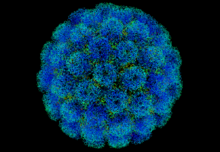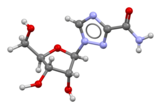Our website is made possible by displaying online advertisements to our visitors.
Please consider supporting us by disabling your ad blocker.
Portal:Viruses
The Viruses Portal
Welcome!

Viruses are small infectious agents that can replicate only inside the living cells of an organism. Viruses infect all forms of life, including animals, plants, fungi, bacteria and archaea. They are found in almost every ecosystem on Earth and are the most abundant type of biological entity, with millions of different types, although only about 6,000 viruses have been described in detail. Some viruses cause disease in humans, and others are responsible for economically important diseases of livestock and crops.
Virus particles (known as virions) consist of genetic material, which can be either DNA or RNA, wrapped in a protein coat called the capsid; some viruses also have an outer lipid envelope. The capsid can take simple helical or icosahedral forms, or more complex structures. The average virus is about 1/100 the size of the average bacterium, and most are too small to be seen directly with an optical microscope.
The origins of viruses are unclear: some may have evolved from plasmids, others from bacteria. Viruses are sometimes considered to be a life form, because they carry genetic material, reproduce and evolve through natural selection. However they lack key characteristics (such as cell structure) that are generally considered necessary to count as life. Because they possess some but not all such qualities, viruses have been described as "organisms at the edge of life".
Selected disease
Measles is a disease that only affects humans caused by the measles virus, an RNA virus in the Paramyxoviridae family. It is highly contagious, with transmission occurring via the respiratory route or by contact with secretions. Symptoms generally develop 10–12 days after exposure and last 7–10 days; they include high fever, cough, rhinitis and conjunctivitis, white Koplik's spots inside the mouth and a generalised red maculopapular rash. Complications including diarrhoea, otitis media and pneumonia are relatively common; more rarely seizures, encephalitis, croup, corneal ulceration and blindness can occur. The risk of death is usually around 0.2%, but may be as high as 10–28% in areas with high levels of malnutrition and poor healthcare.
Measles was first described by Rhazes (860–932). The disease is estimated to have killed around 200 million people between 1855 and 2005. It affects about 20 million people a year, primarily in the developing areas of Africa and Asia, and is one of the leading vaccine-preventable disease causes of death. No antiviral drug is licensed. An effective measles vaccine is available, but uptake has been reduced by anti-vaccination campaigns, particularly the fraudulent claim that the MMR vaccine might be associated with autism. Rates of disease and deaths increased from 2017 to 2019, attributed to a decrease in immunisation.
Selected image
Lady Mary Wortley Montagu survived smallpox, and popularised the Turkish practice of variolation against the disease in western Europe in the 1720s.
Credit: Jean-Étienne Liotard (c. 1756)
In the news
26 February: In the ongoing pandemic of severe acute respiratory syndrome coronavirus 2 (SARS-CoV-2), more than 110 million confirmed cases, including 2.5 million deaths, have been documented globally since the outbreak began in December 2019. WHO
18 February: Seven asymptomatic cases of avian influenza A subtype H5N8, the first documented H5N8 cases in humans, are reported in Astrakhan Oblast, Russia, after more than 100,0000 hens died on a poultry farm in December. WHO
14 February: Seven cases of Ebola virus disease are reported in Gouécké, south-east Guinea. WHO
7 February: A case of Ebola virus disease is detected in North Kivu Province of the Democratic Republic of the Congo. WHO
4 February: An outbreak of Rift Valley fever is ongoing in Kenya, with 32 human cases, including 11 deaths, since the outbreak started in November. WHO
21 November: The US Food and Drug Administration (FDA) gives emergency-use authorisation to casirivimab/imdevimab, a combination monoclonal antibody (mAb) therapy for non-hospitalised people twelve years and over with mild-to-moderate COVID-19, after granting emergency-use authorisation to the single mAb bamlanivimab earlier in the month. FDA 1, 2
18 November: The outbreak of Ebola virus disease in Équateur Province, Democratic Republic of the Congo, which started in June, has been declared over; a total of 130 cases were recorded, with 55 deaths. UN
Selected article
RNA interference is a type of gene silencing that forms an important part of the immune response against viruses and other foreign genetic material in plants and many other eukaryotes. A cell enzyme called Dicer (pictured) cleaves double-stranded RNA molecules found in the cell cytoplasm – such as the genome of an RNA virus or its replication intermediates – into short fragments termed small interfering RNAs (siRNAs). These are separated into single strands and integrated into a large multi-protein RNA-induced silencing complex, where they recognise their complementary messenger RNA (mRNA) molecules and target them for destruction. This prevents the mRNAs acting as a template for translation into proteins, and so inhibits, or silences, the expression of viral genes.
RNA interference allows the entire plant to respond to a virus after a localised encounter, as the siRNAs can transfer between cells via plasmodesmata. The protective effect can be transferred between plants by grafting. Many plant viruses have evolved elaborate mechanisms to suppress this response. RNA interference evolved early in eukaryotes, and the system is widespread. It is important in innate immunity towards viruses in some insects, but relatively little is known about its role in mammals. Research is ongoing into the application of RNA interference to antiviral treatments.
Selected outbreak
The 1993 hantavirus outbreak in the Four Corners region of southwest USA was of a novel hantavirus, subsequently named Sin Nombre virus. It caused the previously unrecognised hantavirus pulmonary syndrome – the first time that a hantavirus had been associated with respiratory symptoms. Mild flu-like symptoms were followed by the sudden onset of pulmonary oedema, which was fatal in half of those affected. A total of 24 cases were reported in April–May 1993, with many of those affected being from the Navajo Nation territory. Hantavirus infection of humans generally occurs by inhaling aerosolised urine and faeces of rodents, in this case the deer mouse (Peromyscus; pictured).
Previously documented hantavirus disease had been confined to Asia and Europe, and these were the first human cases to be recognised in the USA. Subsequent investigation revealed undiagnosed cases dating back to 1959, and Navajo people recalled similar outbreaks in 1918, 1933 and 1934.
Selected quotation
| “ | ...in a flash I had understood: what caused my clear spots was, in fact, an invisible microbe, a filterable virus, but a virus parasitic on bacteria. | ” |
—Félix d'Herelle on the discovery of bacteriophages
Recommended articles
Viruses & Subviral agents: bat virome • elephant endotheliotropic herpesvirus • HIV • introduction to viruses![]() • Playa de Oro virus • poliovirus • prion • rotavirus
• Playa de Oro virus • poliovirus • prion • rotavirus![]() • virus
• virus![]()
Diseases: colony collapse disorder • common cold • croup • dengue fever![]() • gastroenteritis • Guillain–Barré syndrome • hepatitis B • hepatitis C • hepatitis E • herpes simplex • HIV/AIDS • influenza
• gastroenteritis • Guillain–Barré syndrome • hepatitis B • hepatitis C • hepatitis E • herpes simplex • HIV/AIDS • influenza![]() • meningitis
• meningitis![]() • myxomatosis • polio
• myxomatosis • polio![]() • pneumonia • shingles • smallpox
• pneumonia • shingles • smallpox
Epidemiology & Interventions: 2007 Bernard Matthews H5N1 outbreak • Coalition for Epidemic Preparedness Innovations • Disease X • 2009 flu pandemic • HIV/AIDS in Malawi • polio vaccine • Spanish flu • West African Ebola virus epidemic
Virus–Host interactions: antibody • host • immune system![]() • parasitism • RNA interference
• parasitism • RNA interference![]()
Methodology: metagenomics
Social & Media: And the Band Played On • Contagion • "Flu Season" • Frank's Cock![]() • Race Against Time: Searching for Hope in AIDS-Ravaged Africa
• Race Against Time: Searching for Hope in AIDS-Ravaged Africa![]() • social history of viruses
• social history of viruses![]() • "Steve Burdick" • "The Time Is Now" • "What Lies Below"
• "Steve Burdick" • "The Time Is Now" • "What Lies Below"
People: Brownie Mary • Macfarlane Burnet![]() • Bobbi Campbell • Aniru Conteh • people with hepatitis C
• Bobbi Campbell • Aniru Conteh • people with hepatitis C![]() • HIV-positive people
• HIV-positive people![]() • Bette Korber • Henrietta Lacks • Linda Laubenstein • Barbara McClintock
• Bette Korber • Henrietta Lacks • Linda Laubenstein • Barbara McClintock![]() • poliomyelitis survivors
• poliomyelitis survivors![]() • Joseph Sonnabend • Eli Todd • Ryan White
• Joseph Sonnabend • Eli Todd • Ryan White![]()
Selected virus
Rotavirus is a genus of double-stranded RNA viruses in the family Reoviridae. There are nine species A–I; rotavirus A, the most common, causes over 90% of infections in humans. Rotavirus also infects animals, including livestock. The virus is transmitted by the faecal–oral route, with fewer than 100 virus particles being required for infection. Rotaviruses are stable in the environment and normal sanitary measures fail to protect against them. Effective rotavirus vaccines are the main prevention method.
The virus infects and damages the enterocytes lining the small intestine, causing gastroenteritis (sometimes referred to as "stomach flu," although the virus is not related to influenza). A viral toxin, NSP4, is responsible for some of the pathology. Rotavirus is the most common cause of diarrhoea among infants and young children. Almost every child worldwide has been infected with rotavirus at least once by the age of five. In 2013, 215,000 children under five died from rotavirus infection, mostly in developing countries, and almost two million more become severely ill. Immunity develops with each infection and adults are rarely affected.
Did you know?
- ...that the stripes on tulips (examples pictured) that caused tulip mania were probably caused by a virus, but this was unknown to science at the time?
- ...that epidemiologist Li Lanjuan was the first to propose a lockdown of Wuhan during the 2019–20 coronavirus outbreak?
- ...that the human bocavirus is the fourth most commonly found virus in samples collected from the respiratory system?
- ...that research by Harold Ginsberg on adenoviruses led to the development of gene therapy, in which modified versions of viruses can be used to implant healthy versions of genes to treat disease?
- ...that the Tiverton fire of 1731 resulted in an increased incidence of smallpox?
Selected biography
Frederick Sanger (13 August 1918 – 19 November 2013) was a British biochemist, the only person to have been awarded the Nobel Prize in Chemistry twice.
He started to research nucleic acid sequencing in the early 1960s. In 1975, he co-invented the "Plus and Minus" technique for sequencing DNA, which could sequence 80 nucleotides at once, a significant improvement on earlier techniques. Using this method, his group sequenced most of the 5,386 nucleotides of φX174 bacteriophage – the first virus and the first DNA genome to be completely sequenced – and showed that some of its genes overlapped. In 1977, he and his group pioneered the Sanger (or dideoxy chain-termination) method for sequencing DNA and used it to sequence the 48,502 bp bacteriophage λ. His technique remained the most widely used sequencing method until the mid-2000s, and was used to generate the first human genome sequence. Sanger is also known for sequencing bovine insulin, the first protein to be sequenced. The Sanger Institute was named for him.
In this month
February 1939: First virology journal, Archiv für die gesamte Virusforschung, appeared
8 February 1951: Establishment of the HeLa cell line from a cervical carcinoma biopsy, the first immortal human cell line
12 February 1892: Dmitri Ivanovsky (pictured) demonstrated transmission of tobacco mosaic disease by extracts filtered through Chamberland filters; sometimes considered the beginning of virology
19 February 1966: Prion disease kuru shown to be transmissible
23 February 2018: Baloxavir marboxil, the first anti-influenza agent to target the cap-dependent endonuclease activity of the viral polymerase, approved in Japan
27 February 2005: H1N1 influenza strain resistant to oseltamivir reported in a human patient
24 February 1977: Phi X 174 sequenced by Fred Sanger and coworkers, the first virus and the first DNA genome to be sequenced
28 February 1998: Publication of Andrew Wakefield's Lancet paper, subsequently discredited, linking the MMR vaccine with autism, which started the MMR vaccine controversy
Selected intervention
Ribavirin is a nucleoside analogue that mimics the nucleoside guanosine. It shows some activity against a broad range of DNA and RNA viruses, but is less effective against dengue fever, yellow fever and other flaviviruses. The drug was first synthesised in the early 1970s by Joseph T. Witkowski and Roland K. Robins. Ribavirin's main current use is against hepatitis C, in combination with pegylated interferon, nucleotide analogues and protease inhibitors. It has been used in the past in an aerosol formulation against respiratory syncytial virus-related diseases in children. Ribavirin has been used in combination as part of an experimental treatment for rabies. It is also the only available treatment for the viruses causing some viral haemorrhagic fevers, including Lassa fever, Crimean–Congo haemorrhagic fever and hantavirus disease, but is ineffective against the filovirus diseases, Ebola and Marburg. Clinical use is limited by the drug building up in red blood cells to cause haemolytic anaemia.
Subcategories
Subcategories of virology:
Topics
Things to do
- Comment on what you like and dislike about this portal
- Join the Viruses WikiProject
- Tag articles on viruses and virology with the project banner by adding {{WikiProject Viruses}} to the talk page
- Assess unassessed articles against the project standards
- Create requested pages: red-linked viruses | red-linked virus genera
- Expand a virus stub into a full article, adding images, citations, references and taxoboxes, following the project guidelines
- Create a new article (or expand an old one 5-fold) and nominate it for the main page Did You Know? section
- Improve a B-class article and nominate it for Good Article
 or Featured Article
or Featured Article status
status - Suggest articles, pictures, interesting facts, events and news to be featured here on the portal
WikiProjects & Portals
 WikiProject Viruses
Related WikiProjects
WikiProject Viruses
Related WikiProjects
Medicine • Microbiology • Molecular & Cellular Biology • Veterinary Medicine
Related PortalsAssociated Wikimedia
The following Wikimedia Foundation sister projects provide more on this subject:
-
Commons
Free media repository -
Wikibooks
Free textbooks and manuals -
Wikidata
Free knowledge base -
Wikinews
Free-content news -
Wikiquote
Collection of quotations -
Wikisource
Free-content library -
Wikispecies
Directory of species -
Wikiversity
Free learning tools -
Wiktionary
Dictionary and thesaurus
Previous Page Next Page





















